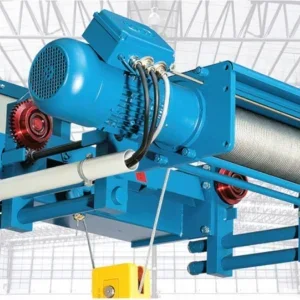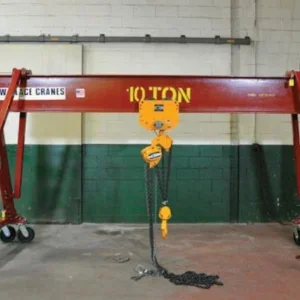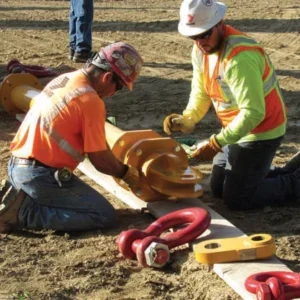Investment banks Lehman Brothers and Goldman Sachs managed the plan within which, initially, both a sale of the company and a flotation were considered.
Demag was, previously, 81% owned by US venture capital firm Kohlberg Kravis Roberts & Co (KKR). The remainder was owned by German industrial group Siemens.
The company already had a complex recent history. It was hived off from long-time owner Mannesmann Dematic in 2000 into a new firm called Atecs, which was taken over by Bosch and Siemens in 2001. In July 2002, the majority of the company was bought by KKR, and the minority retained by Siemens. CEO Harald Joos joined the company in December 2003.
Hering Schuppener typically advise businesses on Initial Public Offers (IPOs). As former employee and new head of Demag’s corporation communications Nikolai Juchem (pictured, below) puts it, “we particularly advised on situations that were critical to the success of the business but to a minor extent the day to day running of it.”
Juchem says he was aware of the brand Demag before he started working alongside its owners. “I knew the name Demag because it is a strong brand but at the time I didn’t even associate it with cranes,” he says. He remembers being impressed immediately with its portfolio even if, at the time, securing employment with the company was the furthest thing from his mind.
The owners first communicated their plans to dispose of the Demag and Gottwald businesses in January and started on the road to an IPO at the end of March. Although Juchem did not want to speculate on the timeframe KKR had in mind when securing a majority share in Demag, he did say that private equity companies will always be looking to sell once the targeted return price could be realised. As he puts it, they would always have had a timeframe in mind.
The first big decision Juchem and the IPO team had to make was to establish a holding brand (the one to be recognised on the stock market).
There are two major brands under the Demag Cranes AG umbrella – Demag and Gottwald – but Demag Cranes AG was finally chosen because the owners were convinced in its strength due to the long tradition of the Demag brand, Juchem says. But, he states, “you can never say this will be forever because the most important thing is that the brand recognition on the customers´ side will not be diluted by any holding related PR or marketing.” This is a big part of Juchem’s newly created role. In fact, it was his influence that led the company to the decision to appoint someone in this position.
Juchem says Hering Schuppener’s advice at this time was crucial to the success of the flotation – and the future of the business. For example, he says, the board members of Demag Cranes had not worked for a listed company before. As a consequence, they had to be trained for media and capital market purposes such as press conferences and investor road shows.
The entire communication advisory team consisted of up to six people – there were two to four senior consultants and some support staff. Most of the people involved in the IPO preparation worked on average 16 hours a day for up to six weeks on the float.
KKR and Siemens followed a dual track which meant they could opt at the last minute for an IPO or a sale of the company in a different context.
Juchem explains that “if you decide on going for an IPO the time frame is usually very tight because it’s more demanding due to regulatory issues. Both systems are mapped out for companies in parallel.”
Juchem says that according to bankers this was the most ambitious IPO in terms of the time frame in which it had to be executed that he had worked on in Germany in 2006.
The book building process began in June but Juchem recalls that due to the weak stock market conditions in May and June, investors demanded that the share price was lowered. This delayed the float (albeit for only three days), which was originally scheduled for Tuesday 20 June, where it was believed that 70% of the company would be floated. Demag’s net debt (including pensions) was around Euros 315m. Equity value was around the Euros 700m mark.
Juchem recalls that at this time the value of shares in Finnish manufacturer Konecranes (a competitor of comparable size and business focus as he puts it) dropped by about 25%.
As this stage the company were faced with three alternatives:
• postpone the flotation for, say, six weeks
• cancel the IPO and try an alternative sale arrangement
• lower the share price range
Juchem says that it was not an obvious decision to lower the price, saying that in the UK, for example, a lot of IPOs did not even take place because of this scenario.
The initial share price range was 26-31 Euros per share. This was dropped to 22 Euros per share.
Today, Juchem says, the share price is over 30 Euros per share.
Juchem describes the flotation as “absolutely positive for every stakeholder,” and not just the shareholders. There are three major categories these so-called stakeholders fall into – namely customers, employees and shareholders.
Juchem says that questions have and will continue to come from people, mainly asking how does this effect them and their day to day jobs – especially employees of the company itself.
“The answer,” says Juchem, “is that it doesn’t really effect them at all.”
There are Demag Cranes facilities all over the world and the IPO makes no big difference to them, he insists. “Yes,” he continues, “they would have heard of the creation of Demag Cranes AG, but that’s mostly it.”
Juchem admits that his biggest challenge is to improve the flow of information and portray the flotation in a positive light, thus elaborating its benefits to each stakeholder.






